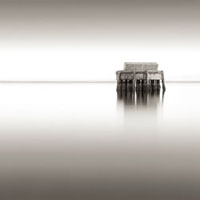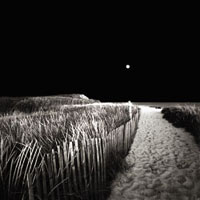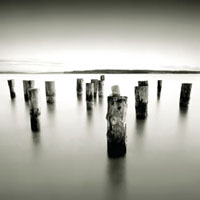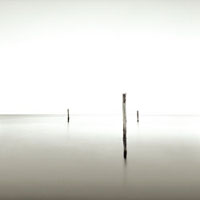Resonant Images
The Photography Of David Fokos
It is a spiritually rewarding
experience to stand before the black and white photographs of David
Fokos. The mood created by the large areas of rich blacks is haunting
while the isolation of objects conjures questions. Rickety poles appear
out of context. Rocks sit in a flat, motionless sea and we wonder if
something is amiss. Perhaps the effect comes from the gripping silence
and the sheer beauty of minimalism in our midst. |
|||
Print Inspiration |
|||
"There are many people
who, when they find I am working in Photoshop, assume the still water
and crisp horizon they see is created on the computer. But," Fokos
explains, "that surreal quality is really the result of long exposures.
There are always waves in the ocean. There is motion while the exposure
is going on. The water does not sit still to have its picture taken.
Because the exposure is long--anywhere from 11/2 minutes to 10
minutes--there is stillness rather than movement and blur. In the
daytime, along with the lengthy exposures, I add dark filters to my
lens and stop down my aperture to f/64 to reduce the amount of light
getting in there. In one photograph taken on Storrow Drive in Boston
there were 579 cars that went in front of the camera during that 10
minutes, yet you don't see any of them." |
|||
RGB Tonality |
|||
"The lasers are right
near the surface of the print, enabling the image to retain detail
at extreme enlargements," says Fokos. "An ordinary negative
would be up high in an enlarger and the light would go through a lens
that would be projected and obviously the more the enlargement is
increased, the fuzzier the final print. With the laser that problem
doesn't exist and the prints have tremendous sharpness. |
|||
High Frequency Perception |
|||
"So when people say
that my picture does not look real, they are wrong. My picture is
very real. The light reflected off that scene before me is recorded
on the film. It is a recording of real events." |
|||
Although it is difficult to put this "energy" into words, David Fokos' prints have achieved high regard and are widely collected. "These things I am exposing exist in nature so they affect everyone, but I am actually interested in seeing them whereas most people may have no intellectual interest in them. I am trying to make the viewer aware," he says, "and that is why the images seem to resonate within people and whether or not they understand it, on some level they recognize the fact that the photograph is what they are responding to." |
|||
BIO |









































